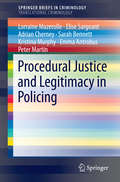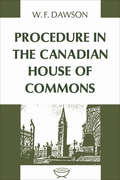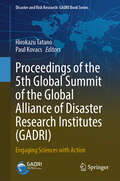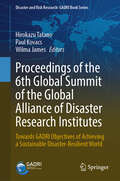- Table View
- List View
Procedural Justice and Legitimacy in Policing
by Peter Martin Adrian Cherney Sarah Bennett Lorraine Mazerolle Elise Sargeant Kristina Murphy Emma AntrobusThis brief focuses on the "doing" of procedural justice: what the police can do to implement the principles of procedural justice, and how their actions can improve citizen perceptions of police legitimacy. Drawing on research from Australia (Mazerolle et al), the UK (Stanko, Bradford, Jackson etc al), the US (Tyler, Reisig, Weisburd), Israel (Jonathon-Zamir et al), Trinidad & Tobago (Kochel et al) and Ghana (Tankebe), the authors examine the practical ways that the police can approach engagement with citizens across a range of different types of interventions to embrace the principles of procedural justice, including: · problem-oriented policing · patrol · restorative justice · reassurance policing · and community policing. Through these examples, the authors also examine some of the barriers for implementing procedurally just ways of interacting with citizens, and offer practical suggestions for reform. This work will be of interest for researchers in criminology and criminal justice focused on policing as well as policymakers.
Procedural Justice and Relational Theory: Empirical, Philosophical, and Legal Perspectives (Routledge Research in Legal Philosophy)
by Denise Meyerson, Catriona Mackenzie, and Therese MacDermottThis book bridges a scholarly divide between empirical and normative theorizing about procedural justice in the context of relations of power between citizens and the state. Empirical research establishes that people’s understanding of procedural justice is shaped by relational factors. A central premise of this volume is that this research is significant but needs to be complemented by normative theorizing that draws on relational theories of ethics and justice to explain the moral significance of procedures and make normative sense of people’s concerns about relational factors. The chapters in Part 1 provide comprehensive reviews of empirical studies of procedural justice in policing, courts and prisons. Part 2 explores empirical and normative perspectives on procedural justice and legitimacy. Part 3 examines philosophical approaches to procedural justice. Part 4 considers the implications of a relational perspective for the design of procedures in a range of legal contexts. This collection will be of interest to a wide academic readership in philosophy, law, psychology and criminology.
Procedure in the Canadian House of Commons
by William DawsonProcedure in the Canadian House of Commons is an attempt to survey the whole field of Canadian procedure historically and analytically, to establish what the procedure of the House was in 1867 and to trace its slow development—its evolvement through principles, traditions, rulings, and precedents—to the present time. A particular interest has been taken in depicting how the House operates in practice as compared with how it is believed to operate in theory. Throughout his analysis, Dawson provides insightful criticism and proposals for improvement in the hopes that this book will provide a new perspective on procedure both to those who are caught up in the day-to-day functioning of the House and to those, both in the House and outside it, who are concerned about larger, more distant implications.
Proceedings of The Focus Conference (Advances in Social Science, Education and Humanities Research #732)
by Mariam Akinlolu Manyane Makua Mashango Sithole Phiwayinkosi Gumede Cebo NyondoThis is an open access book.It is a common cause globally that the abrupt emergence of Covid-19 wreaked havoc in all sectors, including the higher education system. The sudden closure of campuses as a social distancing measure to prevent community transmission has shifted face-to-face classes to online teaching and learning, a transformative experiment for academics and students in most institutions. This has thrown the focus on utilising Learning Management Systems (LMS), eLearning tools and platforms for effective student engagement, which may have limitations of accessibility and affordability for many students. The pandemic has exposed the shortcomings of the current higher education system and the need for more training of academics and practitioners in digital technology to adapt to the rapidly changing educational climate. In the post-pandemic situation, eLearning and virtual education may become an integral part of the higher education system, hence the question of re-inventing higher education. The higher education institutions and universities need to plan the post-pandemic education and research strategies to ensure student learning outcomes and standards of educational quality. With the move to online teaching and learning, subsequently, traditional assessments followed and were adapted and adopted for online assessment. Assessments lie at the heart of the teaching process. It shapes students’ understanding of the curriculum and determines their ability to progress. Reflections on assessments during Covid-19 abounded with the challenges that both academics and students faced regarding online assessments, including cheating and quality assurance issues. The focus on quality extended to the quality of teaching and learning in general. Moreover, the pandemic brought about the question of staff and student health and psychosocial support also became important. For academics, the abrupt shift to adapt to working from home and implementing online learning has led to over-work, low work-life balance and compromised mental health. With a view on constructive and futuristic discourse, the sub-themes of the 2022 Focus conference encapsulate the current realities in the higher education sector and beyond. It further provides opportunities for an in-depth analysis based on the benefit of hindsight and foresight. The Organising Committee specifically coined the theme, Re-inventing higher education: Insights, trends and lessons learnt from, specifically for the conference to reflect on and address the matters mentioned earlier. Academics, scholars, and practitioners in the higher education sector are called upon to share their research and express their perspectives on the reinvention of higher education.
Proceedings of Topical Issues in International Political Geography (Springer Geography)
by Radomir Bolgov Vadim Atnashev Yury Gladkiy Art Leete Alexey Tsyb Sergey PogodinThis proceedings book addresses the main issues of contemporary political geography and international relations, providing a platform for discussion and collaboration of experts in the fields of Political Geography, Geopolitics, International Relations, and International Law. Participants from all over the world consider the controversies and challenges posed by globalization, focusing, in particular, on the ideologies of globalization and regionalism, migration crises, prevention of ethnic conflicts, and measures to counteract racism, xenophobia, and extremism
Proceedings of Topical Issues in International Political Geography (Springer Geography)
by Andrei Znamenski Radomir Bolgov Vadim Atnashev Yury Gladkiy Art Leete Alexey Tsyb Sergey PogodinThis proceedings book addresses the main issues of contemporary political geography and international relations, providing a platform for discussion and collaboration of experts in the fields of Political Geography, Geopolitics, International Relations, etc. Participants from all over the world consider the controversies and challenges posed by globalization, focusing, in particular, on the ideologies of globalization and regionalism, migration crises, prevention of ethnic conflicts, and measures to promote sustainable development. The content of the book may be interesting to expert community, academics and popular audience.
Proceedings of Topical Issues in International Political Geography (Springer Geography)
by Andrei Znamenski Radomir Bolgov Vadim Atnashev Yury Gladkiy Art Leete Alexey Tsyb Sergey PogodinThis proceedings book addresses the main issues of contemporary political geography and international relations, providing a platform for discussion and collaboration of experts in the fields of Political Geography, Geopolitics, International Relations, etc. Participants from all over the world consider the controversies and challenges posed by globalization, focusing, in particular, on the ideologies of globalization and regionalism, migration crises, prevention of ethnic conflicts, and measures to promote sustainable development. The content of the book may be interesting to expert community, academics and popular audience.
Proceedings of Topical Issues in International Political Geography (Springer Geography)
by Andrei Znamenski Radomir Bolgov Vadim Atnashev Art Leete Alexey Tsyb Sergey Pogodin Yuriy GladkiyThis proceedings book provides selections from the 2022 Topical Issues in International Political Geography (TIPG) meeting. It addresses the main issues of contemporary political geography and international relations, providing a platform for discussion and collaboration of experts primarily in the fields of Political Geography, Geopolitics, and International Relations. Participants from all over the world consider the controversies and challenges posed by globalization, focusing, in particular, on the ideologies of globalization and regionalism, migration crises, prevention of ethnic conflicts, and measures to promote sustainable development. The content of the book will be interesting to experts, academics, and students in these communities.
Proceedings of Topical Issues in International Political Geography (Springer Geography)
by Andrei Znamenski Radomir Bolgov Vadim Atnashev Alexey Tsyb Sergey Pogodin Timo Duile Yuriy GladkiyThis proceedings book provides selections from the 2023 Topical Issues in International Political Geography (TIPG) meeting. This gathering addresses the main issues of contemporary political geography and international relations, providing a platform for discussion and collaboration between an international array of experts primarily in the fields of political geography, geopolitics, and international relations. The first section of this volume focuses on international relations, addressing issues such as multipolarity, small states, transport cooperation, politico-geographical processes, and international security in the context of geographic space. Building on these spatially rooted themes, section two presents contributions that focus on the dual processes of globalization or regionalism. Authors of these chapters use historical frameworks to interrogate the nation state, ideology, identity, symbolisms, sovereignty, and memory. In section three, the focus narrows to specific domestic policies—such as those related to gender, public services, elections, and corruption prevention—situated in contemporary conversations about digital transformations. Section four turns to instruments of cultural policy, examining tourism and (in a new addition in response to developments in the field) education. Similarly, section five introduces a theme new to the conference: migration and socio-demographic processes. These chapters evaluate national, regional, and local aspects of migration and multiculturalism. The final section turns to the still-pressing theme of sustainable development, taking up case studies of nations and international organizations grappling with questions about sustainable growth, political ecology, and environmental culture. The content of the book will be interesting to experts, academics, and students.
Proceedings of the 10th International Conference on Energy Engineering and Environmental Engineering (Environmental Science and Engineering)
by Zuoyu Sun Prodip K. DasThis book contains the proceedings of the 10th International Conference on Energy Engineering and Environmental Engineering (ICEEEE2023) that was held on August 6-8 2023 in Singapore. ICEEEE2023 is organized by Beijing Jiaotong University and Newcastle University. This book provides an international forum for discussion and communication of energy and environmental engineering.It is expected to report the latest technological developments in the fields developed by academic researchers and industrial practitioners, with a focus on renewable energy technologies and systems, energy efficiency and conservation, environmental pollution and control, sustainable development, and green cities. The contents of this proceedings will be useful to researchers, professionals, and policymakers alike.
Proceedings of the 16th Asian Urbanization Conference; AUC2024; 11–13 January; Binh Duong Province–Ho Chi Minh City, Vietnam: Forging a Livable and Sustainable Urban Future (Advances in 21st Century Human Settlements)
by George M. Pomeroy Ha Thuc Vien Nguyen Ngoc HieuThis book highlights peer reviewed articles from the 2024 Asian Urbanization Conference hosted by the Vietnamese German University in Vietnam. It is estimated that Asia continues to be the fastest urbanizing continent in the next few decades with mounting challenges and ample opportunities. The 2024 conference proceedings presents issues and perspectives in both global and local agendas. Findings and discussions from the book would reflect not only our learning how Asian cities and regions are transforming, but also our efforts of &‘Forging a Livable and Sustainable Urban Future&’, globally.
Proceedings of the 2022 Brawijaya International Conference (Advances in Economics, Business and Management Research #235)
by Yusfan Adeputera Yusran Femiana Gapsari Madhi Fitri Titin Andri Wihastuti Fajar Ari Nugroho Indah Dwi QurbaniThis is an open access book.We proudly present the 2022 Brawijaya International Conference (BIC) as the consecutive series of conferences that is organised and hosted annually by Univeritas Brawijaya, Indonesia. The BIC 2022 will be held in Bali, Indonesia, on October 7 – 9, 2022. The conference committee consists of multi department of Univeritas Brawijaya. The BIC 2022 will present multidisciplinary research, community service essay and research, and industrial findings related to sustainable development. The BIC 2022 will be a great opportunity for exchanging ideas and knowledge in all multidisciplinary areas for academicians, scientists, practitioners, and global executives. The event will facilitate a focus group discussion and consultation for the participants, especially stakeholders, to address the current issues and challenges including the future invention and innovation within multidisciplinary areas.The BIC 2022 invites fellow researchers/scientists, students, practitioners, global executives from multidisciplinary areas to participate and gather in this event to share and discuss the related research result and finding from all multidisciplinary areas. You should not miss the great opportunity to establish partnership and acquire tremendous knowledge within the BIC 2022.
Proceedings of the 2022 International Conference on Business and Policy Studies (Applied Economics and Policy Studies)
by Xiaolong Li Chunhui Yuan Ivoslav GanchevThis proceedings volume contains papers accepted by the 2022 International Conference on Business and Policy Studies (CONF-BPS 2022), which are carefully selected and reviewed by professional reviewers from corresponding research fields and the editorial team of the conference. This volume presents latest research achievements, inspirations, and applications in applied economy, finance, enterprise management, public administration, and policy studies. CONF-BPS hopes this volume could be inspiring and of academic value.Business and policy studies both are heated research topics and are related to multiple fields. Held by Eliwise Academy, CONF-BPS aims at bringing together intellectuals from related fields including applied economy, finance, and public administration for academic exchange. Its goal is to serve as an international platform for researchers to present latest research progress, share ideas and inspirations, and exchange experience. Through more academic communication and exchange, this conference hops to promote international corporation and joint initiatives in relevant fields. This volume will be of interest to researchers, academics, professionals, and policy makers in the field of business, economics, management, and policy studies.
Proceedings of the 2022 International Conference on Green Building, Civil Engineering and Smart City (Lecture Notes in Civil Engineering #211)
by Kai Qian Wei GuoThis book of the conference proceedings focuses on innovative design, technology and methods in the fields of building, civil engineering and smart city. It contains a large number of detailed design, construction and performance analysis charts, benefited to students, teachers, research scholars and other professionals in related fields. As well, readers will encounter new ideas for realizing more safe, intelligent and economical buildings.
Proceedings of the 2023 International Conference on Green Building, Civil Engineering and Smart City (Lecture Notes in Civil Engineering #328)
by Kai Qian Lei Gong Wei Guo Honggang TangThe book gathers the emerging technologies and applications in various disciplines involving green building, smart infrastructure and 3D Printing, which are presented in high-quality papers of GBCESC. Moreover, by sharing knowledge and experiences around emerging civil engineering and smart city, the book aims to provide readers with an overview of the emerging trends in the fields of green building, Civil Engineering and Smart City. The topics covered include Structural Engineering, Geological Engineering, Smart Cities, Urban Planning and Design, Construction Technology, green building technology, etc. This book will be useful for researchers and professionals in designing, building, and managing sustainable buildings and infrastructure.
Proceedings of the 25th International Symposium on Advancement of Construction Management and Real Estate
by Yi Peng Weisheng Lu Xinhai Lu Zuo ZhangThis proceedings book focuses on innovation, cooperation, and sustainable development in the fields of construction management and real estate. The book provides a detailed analysis and description of the disciplinary frontiers in the field of building management and real estate and how they can be promoted in the context of the epidemic. A wide variety of papers provide a reference value for both scholars and practitioners. The proceedings book is the documentation of “the 25th International Symposium on Advancement of Construction Management and Real Estate” (CRIOCM 2020), which was held at the School of Public Administration, Central China Normal University, Wuhan, China, in 2020.
Proceedings of the 2nd International Conference on Business and Policy Studies (Applied Economics and Policy Studies)
by Xiaolong Li Canh Thien Dang Javier Cifuentes-FauraThis proceedings volume contains papers accepted by the 2nd International Conference on Business and Policy Studies (CONF-BPS 2023), which are carefully selected and reviewed by professional reviewers from corresponding research fields and the editorial team of the conference. This volume presents the latest research achievements, inspirations, and applications in applied economy, finance, enterprise management, public administration, and policy studies. CONF-BPS 2023 was a hybrid conference that includes several workshops (offline and online) around the world in Cardiff (Jan, 2023), London(Feb, 2023) and Sydney (Feb, 2023). Prof. Canh Thien Dang from King's College London, Prof. Arman Eshraghi from Cardiff Business School, and Prof. Kristle Romero Cortés from UNSW Business School have chaired those offline workshop.
Proceedings of the 2nd International Conference on Trends in Architecture and Construction: ICTAC-2024; 09 April, Chandigarh, India (Lecture Notes in Civil Engineering #527)
by Anurag Varma Vikas Chand Sharma Elena TarsiThis book includes peer reviewed article from the 2nd International Conference on Trends in Architecture and Construction (ICTAC-2024) held at Chandigarh in India. It explores modernity, sustainability, technology, and education within the ever-evolving architectural landscape. This book echoes a collective dedication to fostering environmentally conscious urban practices. It navigates the symbiotic relationship between technology and architecture, shining a spotlight on the pivotal roles of AI, digital tools, and cutting-edge construction techniques. Beyond the tangible, the publication illuminates the shifting terrain of architectural education, honing in on emerging research paradigms and the integration of innovative pedagogies. Rooted in sustainability, this compendium stands as a vibrant repository of insightful contributions, nurturing an expansive dialogue on the future trajectory of architecture.
Proceedings of the 3rd Global Summit of Research Institutes for Disaster Risk Reduction (Disaster and Risk Research: GADRI Book Series)
by Andrew Collins Hirokazu TatanoThis book presents selected papers from the 3rd Global Summit of Research Institutes for Disaster Risk Reduction – Expanding the Platform for Bridging Science and Policy Making, which was held at the Disaster Prevention Research Institute (DPRI), Kyoto University, Uji Campus from 19 to 21 March 2017. It was organised by the Global Alliance of Disaster Research Institutes (GADRI), which was established soon after the second Global Summit and the UN World Conference on Disaster Risk Reduction in March 2015, and is intended to support the implementation of the Sendai Framework for Disaster Risk Reduction 2015–2030.The conference not only provided a platform for discussion and exchange of information on key current and future research projects on disaster risk reduction and management, but also promoted active dialogues through group discussion sessions that addressed various disaster research disciplines.In this book, authors from various disciplines working at governmental and international organisations provide guidance to the science and technical community, discuss the current challenges, and evaluate the research needs and gaps in the context of climate change, sustainable development goals and other interlinked global disaster situations. Expert opinions from practitioners and researchers provide valuable insights into how to connect and engage in collaborative research with the international science and technical communities and other stakeholders to achieve the goals set out in the agenda of the Sendai Framework for Disaster Risk Reduction 2015–2030. In addition, case studies and other evidence-based research papers highlight ongoing research projects and reflect the challenges encountered in information sharing by various stakeholders in the context of disaster risk reduction and management.Chapter “Science and technology commitment to the implementation of the Sendai Framework for Disaster Risk Reduction 2015-2030” is available open access under a Creative Commons Attribution 4.0 International License via link.springer.com.
Proceedings of the 4th Global Summit of Research Institutes for Disaster Risk Reduction: Increasing the Effectiveness and Relevance of Our Institutes (Disaster and Risk Research: GADRI Book Series)
by Andrew Collins Hirokazu TatanoThis book presents selected papers by the keynote speakers and other presenters from various disciplines and includes their opinions and evaluations. The Fourth Global Summit of Research Institutes for Disaster Risk Reduction (4th GSRIDRR, 2019): Increasing the Effectiveness and Relevance of our Institutes, sponsored by the Global Alliance of Disaster Research Institutes (GADRI) and Kyoto University, was hosted by and held at the Disaster Prevention Research Institute (DPRI), Kyoto University, Uji Campus, Kyoto, Japan, 13–15 March 2019..The Global Summit series provided a platform for researchers, practitioners, policy makers, and other stakeholders in both government and non-governmental institutes involved in disaster risk reduction and resilience to come together to discuss, share, and exchange ideas. It focuses specifically on contributing input to the contextualization and revision of the goals of the 2016 Science and Technology Roadmap to implementation of the Priority Areas of the Sendai Framework for Disaster Risk Reduction Agenda 2015–2030, with input for GADRI to move forward in its contributions to the worldwide science community. The conference comprised an impressive array of global stakeholders whose expertise and experience encompassed the management of knowledge and its application for governments and industries, with shared outcomes to bridge science and decision making. It enhanced a process to confront new scientific challenges in disaster risk reduction and disaster risk management.The conference accomplished the following major goals, among others: (1) engagement in dialogue on issues related to disaster prevention and contributions to the Science and Technology Roadmap adopted to support the implementation of the Sendai Framework Agenda 2015–2030; (2) evaluation of current efforts on global and national involvement in the field of disaster prevention research in relation to the implementation of the Priority Areas of the Sendai Framework for Disaster Risk Reduction 2015–2030; (3) assessment of the status of current research knowledge and efforts, and research results at the institutional level in each country.
Proceedings of the 4th International Conference on Economic Management and Green Development (Applied Economics and Policy Studies)
by Xiaolong Li John Kent Chunhui YuanThe proceedings shed light on selected topics including economic management, public administration, and green development. Featuring scholarly works from the 4th International Conference on Economic Management and Green Development (ICEMGD 2021), this volume of proceedings showcases the papers composed with regard to a diverse range of topics situated at the intersecting field of Economic Management, Public Administration and Green Development. Arising as the top concern of the global community, issues of green development impose challenges for the academia to bridge the interdisciplinary prowess in tackling the gap of knowledge within concerned fields. ICEMGD 2021 is an annual conference initiated by the year of 2017 under the goal of bringing together intellectuals from economics, business management, public administration, and otherwise related spheres for the share of research methods and theoretical breakthroughs. The aim of the proceeding volume is for the integration of social scientific research methods with research into alarming development issues. The ICEMGD 2021 seeks to promote joint initiatives among well-established fields like macro- and microeconomics, international economics, finance, agricultural economics, health economics, business management and marketing strategies, regional development studies, social governance, and sustainable development. Featuring interdisciplinary contributions, this book will be of interest to researchers, academics, professionals and policy makers in the field of economic management, public administration, and development studies.
Proceedings of the 5th Brazilian Technology Symposium: Emerging Trends, Issues, and Challenges in the Brazilian Technology, Volume 2 (Smart Innovation, Systems and Technologies #202)
by Yuzo Iano Rangel Arthur Osamu Saotome Guillermo Kemper Ana Carolina Borges MonteiroThis book presents the proceedings of the 5th Edition of the Brazilian Technology Symposium (BTSym). This event brings together researchers, students and professionals from the industrial and academic sectors, seeking to create and/or strengthen links between issues of joint interest, thus promoting technology and innovation at nationwide level. The BTSym facilitates the smart integration of traditional and renewable power generation systems, distributed generation, energy storage, transmission, distribution and demand management. The areas of knowledge covered by the event are Smart Designs, Sustainability, Inclusion, Future Technologies, IoT, Architecture and Urbanism, Computer Science, Information Science, Industrial Design, Aerospace Engineering, Agricultural Engineering, Biomedical Engineering, Civil Engineering, Control and Automation Engineering, Production Engineering, Electrical Engineering, Mechanical Engineering, Naval and Oceanic Engineering, Nuclear Engineering, Chemical Engineering, Probability and Statistics.
Proceedings of the 5th Global Summit of the Global Alliance of Disaster Research Institutes: Engaging Sciences with Action (Disaster and Risk Research: GADRI Book Series)
by Hirokazu Tatano Paul KovacsThis book presents selected papers from the 5th Global Summit of the Global Alliance of Disaster Research Institutes (GADRI)—Engaging Sciences with Action, which was held virtually and regionally from 31 August to 1 September 2021. The Summit reappraised progress and achievements in disaster risk reduction research by the members towards the targets of the science and technology roadmap to implement the goals and priorities of the Sendai Framework for Disaster Risk Reduction 2015–2030. The programme communicated academic science across various scientific disciplines to policymakers and practitioners. This cross-disciplinary aspect is important for academics to be aware of how science can directly contribute to mitigate national and local disasters, for example, the global pandemic COVID-19, earthquakes and volcanic eruptions. The Global Summit of GADRI was attentive to the necessary influence of the Global Alliance and its supporting regional alliances to reflect disaster research into the outcome of the United Nations Climate Change Conference of the Parties (COP26) that took place in Glasgow, UK, in November 2021. The summit contributed to COP26 and provided an impetus to climate change mitigation and adaptation, and health challenges for climate policy to work in the framework of disaster resilience and response. Facilitated through the UK Alliance for Disaster Research, the recommendations by the 5th Global Summit of GADRI were presented at COP26 as well as the United Nations Office for Disaster Risk Reduction (UNDRR)’s Global Platform for Disaster Risk Reduction titled “From Risk to Resilience: Towards Sustainable Development for All in a COVID-19 Transformed World”, which was held in Bali, Indonesia, from 23 to 28 May 2022.
Proceedings of the 5th International Conference on Economic Management and Green Development (Applied Economics and Policy Studies)
by Xiaolong Li John Kent Chunhui YuanThe proceedings consist of papers accepted by the 5th ICEMGD, which are carefully selected and reviewed by professional reviewers from corresponding research fields and the editing committee of the conference. The papers have a diverse range of topics situated at the intersecting field of Economic Management, Public Administration and Green Development. ICEMGD is working to provide a platform for international participants from fields like macro- and microeconomics, international economics, finance, agricultural economics, health economics, business management and marketing strategies, regional development studies, social governance, and sustainable development. This proceedings volume, together with the conference, looks forward to spark inspirations and promote collaborations. It will be of interest to researchers, academics, professionals and policy makers in the field of economic management, public administration, and development studies. Due to COVID-19, ICEMGD was held online on 12-17 August, 2021.
Proceedings of the 6th Global Summit of the Global Alliance of Disaster Research Institutes: Towards GADRI Objectives of Achieving a Sustainable Disaster-Resilient World (Disaster and Risk Research: GADRI Book Series)
by Hirokazu Tatano Paul Kovacs Wilma JamesThis book contains the proceedings of the 6th Global Summit of the Global Alliance of Disaster Research Institutes (GADRI) with the sub-theme of &“Towards GADRI Objectives of Achieving a Sustainable Disaster-Resilient World&”. The conference was held at the Disaster Prevention Research Institute (DPRI), Kyoto University, Uji Campus, Kyoto, Japan, 15–17 March 2023. The prolonged worldwide coronavirus pandemic and cascading risks have taught us that the conventional approach to disaster risk planning and management is ineffective for the development of sustainable and resilient communities. A worldwide pandemic underscores the importance of the following key points: i) Disaster risk should not be treated in isolation but should be integrated with health risks, climate change, and environmental risks ii) Objectives and a vision of disaster risk reduction (DRR) should be integrated with sustainable development goals to foster a resilient world iii) Short-term DRR objectives need to be integrated with a long-term vision and plans for a resilient society The conference discussions focused on how we could move towards a sustainable and resilient society by integrating the above three aspects in GADRI research and development. There were two panel group discussion sessions. The first session explored how GADRI objectives could contribute to achieving a sustainable and resilient society against disasters using the now-launched committees. The second session took these themes further to discuss new challenges for action by GADRI, based on the following themes: - Big Science for DRR: Large-Scale Experiments - Sustainable DRR: Integrating Climate Action, SDGs, Field DRR Experience Sharing – New Challenges for Action by GADRI - Gender and Inclusivity in DRR Policy and Practice - Putting Health into Disaster Risk Reduction (DRR) and Recovery - Young Scientists Session on Youth DRR – Role of Youth and Young Professionals in Data Knowledge Sharing in Disaster Risk Management The conference presentations focused on progress, strategies and challenges, discussing how best to play an important role collectively as GADRI to influence the decision-making process for DRR across the board.
























